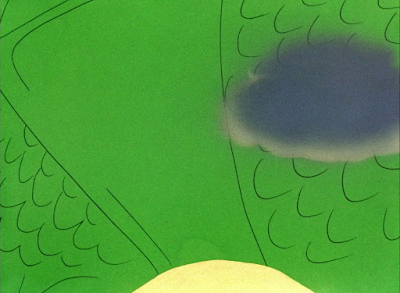Think about it for a minute. How many cartoons take place on a low-budget theatre stage inside a scarecrow? I can think of a grand total of one—MGM’s
Romeo in Rhythm (1940).
As you might expect in a Metro cartoon of this year, there is plenty of animation on ones, but because it’s a musical with singing and dancing, it doesn’t seem over-animated with movement for the sake of movement.
There’s a good story-line woven through the cartoon. Romeo woos Juliet in swing-time, but is constantly interrupted. That’s worked into the music, when Romeo kicks away his mandolin (a guitar is heard on the soundtrack) and sings “You’ve Got to Be Alone to Woo.” The song doesn’t come from an MGM musical. It was written by, of all people, Bill Hanna and Joe Barbera, with music by Scott Bradley. Hanna and Barbera’s lyrics are clever and a far cry from “Pixie Dixie, deedly dum, are the best of friends.”
In one scene, theatre backdrops roll down from the rafters, each painting suiting the verse of the song. Romeo and Juliet stick their heads through holes where heads should be on the painting, like a painted board on Coney Island. The stylised humans are certainly different for an animated cartoon of 1940.









This dissolve looks awkward when viewed frame-by-frame but when watching it on the screen, I suspect audiences weren’t put off by it because it happens at the end of a bar of music.

“At last you’re alone, just you two,” sings Romeo. At that moment, lights come up to reveal rows of heads. The camera pulls back to show a blinking sign. Romeo carries on with the lyrics: “You parked in that hole called the Hollywood Bowl.”



Another good sequence is earlier in the short where Romeo falls into a pile of metallic junk and emerges like the Tin Man from
The Wizard of Oz. Bradley scores “We’re Off to See the Wizard” on the soundtrack as Romeo stumbles around and tries to remove all the junk. (The DVNR on the home video version of this is just disgraceful).

“Metro-Goldwyn-Mayer Shorts Story” magazine of July-August 1940 gives a summary of the cartoon (crediting the direction to Hugh Harman instead of Rudy Ising, though there’s no screen credit for anyone).
Boxoffice magazine of July 27, 1940 reported Bradley was scoring the short, while the
Hollywood Reporter of August 5 announced the cartoon was finished (mentioning the score included songs from
Broadway Melody). The release date was August 10 (“Woo” was copyrighted Sept. 3). No animators were credited but I would bet Mark Kausler knows if we are seeing the work of Jack Zander, Bill Littlejohn, George Gordon and Carl Urbano.
The cartoon got mixed reviews when it was released. Uncle Walt was still the gold standard (no doubt to the annoyance of Harman).
Boxoffice called the cartoon “An acceptable cartoon, but not beyond...The cartoon work is standard, which reminds that it is not Disney. With emphasis on that score.” “Fair,” declared
The Exhibitor in one word.
Motion Picture Daily was more enthusiastic. “This is a travesty in cartoon on ‘Romeo and Juliet,’ produced skillfully by Hugh Harmon [sic]. It should add a bright touch to any problem. The characters are crows which sing a few snappy tunes in Harlem jive fashion.”
Showman’s Trade Review felt “There’s a good idea in this cartoon but it misses fire somewhere. A couple of birds (ravens) play Romeo and Juliet (colored version). There are a lot of gags some of which are funny, but the subject bogs down in the middle and doesn’t get anywhere. It results in just a fair cartoon.”
Motion Picture Herald liked it a little better, calling it “an amusing cartoon.” Exhibitor Walter Pyle of the newly-opened Dreamland Theatre in Rockglen, Saskatchewan pronounced to that publication “Just another cartoon. A few kiddies snickered a little.” A “Harlem” short seems like an odd choice for a Canadian prairie farm town of maybe a couple of hundred people. But it was screened as well in Bengough, Sask., where the manager told the
Herald it was “very entertaining.” The paper was told by the operator of a theatre in Dewey, Oklahoma is was a “good cartoon” but “the kids did not understand or appreciate it.”
To be honest, it’s tough feeling sympathetic for Romeo at the end when Juliet leaves him and runs off to work. It’s because they’re not real characters and the situation isn’t real. They’re actors performing a play on stage.

Mel Blanc provides a couple of voices on this short but the star is Billy Mitchell, who puts in a fine singing performance as Romeo. Juliet is Lillian Randolph (right), who found more work in MGM cartoons as the maid in the Tom and Jerry series. They both lent voices to the MGM musical short
Swing Social (also 1940), a cartoon featuring Amos ‘n’ Andy accents, Uncle Tom, fish with thick minstrel-show lips, a razor and irresistible fried chicken.
Mitchell was a veteran at the time, billed in
The Billboard in 1922 as “the boy with the insane feet.” The same year these two cartoons were released, he appeared as the Lord High Executioner in “The Swing Mikado,” with an all-black cast. By the late ‘40s, Mitchell was a pioneer of the parade of party-record comedians, with one release called
“The Bumble Bee Invaded the Nudist Colony,” and appeared year after year at the Club DeLisa in Chicago. He was dead by the late ‘50s. Judging by newspapers of the day,
Romeo in Rhythm vanished from screens long before that. It was never re-issued.
























































